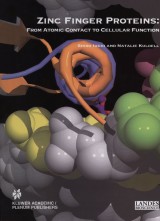Details

Zinc Finger Proteins
From Atomic Contact to Cellular FunctionMolecular Biology Intelligence Unit
|
149,79 € |
|
| Verlag: | Springer |
| Format: | |
| Veröffentl.: | 06.03.2007 |
| ISBN/EAN: | 9780387274218 |
| Sprache: | englisch |
| Anzahl Seiten: | 276 |
Dieses eBook enthält ein Wasserzeichen.
Beschreibungen
In the early 1980s, a few scientists started working on a Xenopus transcription factor, TFIIIA. They soon discovered a novel domain associated with zinc, and named this domain "zinc finger. " Th e number of proteins with similar zinc fingers grew quickly and these proteins are now called C2H2, Cys2His2 or classical zinc finger proteins. To date, about 24,000 C2H2 zinc finger proteins have been recognized. Approximately 700 human genes, or more than 2% of the genome, have been estimated to encode C2H2 finger proteins. From the beginning these proteins were thought to be numerous, but no one could have predicted such a huge number. Perhaps thousands of scientists are now working on C2H2 zinc finger proteins fi-om variou s viewpoints. This field is a good example of how a new science begins with the insight of a few scientists and how it develops by efforts of numerous independent scientists, in contrast to a policy-driven scientific project, such as the Human Genome Project, with goals clearly set at its inception and with work performed by a huge collaboration throughout the world. As more zinc finger proteins were discovered, several subfamilies, such as C2C2, CCHC, CCCH, LIM, RING, TAZ, and FYVE emerged, increasing our understanding of zinc fingers. The knowledge was overwhelming. Moreover, scientists began defining the term "zinc finger" differently and using various names for identical zinc fingers. These complications may explain why no single comprehensive resource of zinc finger proteins was available before this publication.
The Discovery of Zinc Fingers and Their Practical Applications in Gene Regulation: A Personal Account.- The Discovery of Zinc Fingers and Their Practical Applications in Gene Regulation: A Personal Account.- Binding of Zinc Fingers to DNA.- C2H2 Zinc Fingers As DNA Binding Domains.- TFIIIA: A Sophisticated Zinc Finger Protein.- GAGA: Structural Basis for Single Cys2His2 Zinc Finger-DNA Interaction.- The DNA-Binding Domain of GATA Transcription Factors—A Prototypical Type IV Cys2-Cys2 Zinc Finger.- MutM: Single C2C2 Zinc Finger-DNA Interaction.- Homing Endonuclease I-TevI: An Atypical Zinc Finger with a Novel Function.- Zinc Finger Interactions with Metals and Other Small Molecules.- Synthetic Zinc Finger Transcription Factors.- Binding of Zinc Fingers to RNA.- TFIIIA and p43: Binding to 5S Ribosomal RNA.- RNA Binding by Single Zinc Fingers.- Wig-1, a p53-Induced Zinc Finger Protein that Binds Double Stranded RNA.- Tandem CCCH Zinc Finger Proteins in mRNA Binding.- Ribosomal Zinc Finger Proteins: The Structure and the Function of Yeast YL37a.- Binding of Zinc Fingers to Proteins.- LIM Domain and Its Binding to Target Proteins.- RING Finger-B Box-Coiled Coil (RBCC) Proteins As Ubiquitin Ligase in the Control of Protein Degradation and Gene Regulation.- Structure and Function of the CBP/p300 TAZ Domains.- A Zinc Ribbon Motif Is Essential for the Formation of Functional Tetrameric Protein Kinase CK2.- Binding of Zinc Fingers to Small Molecules.- The FYVE Finger: A Phosphoinositide Binding Domain.- Common Domains Present in Zinc Finger Proteins.- The BTB Domain Zinc Finger Proteins.- KRAB Zinc Finger Proteins: A Family of Repressors Mediating Heterochromatin-Associated Gene Silencing.- The Superfamily of SCAN Domain Containing Zinc Finger Transcription Factors.- Biology ofZinc Finger Proteins.- Sp1 and Huntington’s Disease.- The Role of WT1 in Development and Disease.- Yin Yang 1.- The Multiple Cellular Functions of TFIIIA.- The Role of the Ikaros Gene Family in Lymphocyte Development.- Basonuclin: A Zinc Finger Protein of Epithelial Cells and Reproductive Germ Cells.- ZAS Zinc Finger Proteins: The Other ?B-Binding Protein Family.- Role of GATA Factors in Development.- The Androgen Receptor and Spinal and Bulbar Muscular Atrophy.- The Role of XPA in DNA Repair.- MOF, an Acetyl Transferase Involved in Dosage Compensation in Drosophila, Uses a CCHC Finger for Substrate Recognition.- MDM2: RING Finger Protein and Regulator of p53.- Biology of Zinc Ion.- The Zip Family of Zinc Transporters.- Apoptosis by Zinc Deficiency.
The authors include a Nobel Prize laureate, several founders of zinc finger research and the related research fields, and well-known, cutting edge scientists Includes supplementary material: sn.pub/extras
Diese Produkte könnten Sie auch interessieren:

Alzheimer's Disease: Cellular and Molecular Aspects of Amyloid beta

von: J. Robin Harris, Falk Fahrenholz

213,99 €















